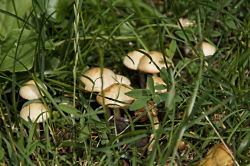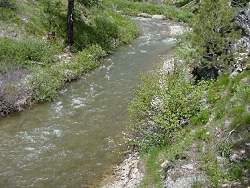
Courtesy MW at Pixabay
Mushrooms are actually the reproductive manifestation of a much larger organism, a brief glimpse of the wonders that reside beneath the ground. Called mycorrhizal fungi, they form a mutually beneficial relationship with tree roots and other plants. They vastly increase the absorption capacity for water and minerals. Many trees and other plants cannot live without these fungal partners. It also makes the plant less susceptible to soil borne pathogens and other environmental stresses such as drought and salinity.
Regarding climate protection, mycelium make up the bulk of carbon storage in forests. Scientists in Sweden were surprised by this; they were expecting dead tree matter to shoulder the carbon burden. But as mycologist Paul Stamets states, “dead mycelium can store carbon for hundreds of thousands of years.
Remarkably, recent research has shown that plants connected by mycorrihzal fungi can use these underground connections to produce and receive warning signals. When a host plant is attacked, the plant signals surrounding plants of its condition. The host plant releases volatile organic compounds (VOCs) that attract the insect’s predators, as do the plants connected by the fungi network.
Further, fungi have been found to have a protective role for plants rooted in soils with high toxic metal concentrations. This is likely due to the metal binding to fungal mycelium.
Taking a broader view, recent research indicates mushrooms possess curative properties for many diseases, including neurological. Add to this bioremediation through cleaning up industrial waste and oil spills, and applications for reducing loss of our pollinators. Critical to soil function as decomposers and providing nutrients, mushrooms also play a major role in soil structure through hyphae networking and glomalin (that is biological glue) production.
The idea that a universal web of dark matter, plus our more familiar World Wide Web, plus the neurological networking in the human brain, all mimicking the mycelial networks of mushrooms under our feet that bind and feed all of Earth’s soil. The idea that this network, an enormous mass of fungus that branches and communicates underground, is in some way sentient. The idea that human brains went through an evolutionary growth spurt after we encountered “magic” mushrooms on the savannah of Africa- all worthy of serious rumination.
Fall has arrived, and with it mushrooms to titillate the imagination- and gastric juices.
This is Jack Greene and boy am I wild about Utah and Pando’s mycelium!
Credits:
Pictures: M W from Pixabay
Sound: Courtesy Kevin Colver
Text: Jack Greene, Bridgerland Audubon Society
Additional Reading:
Pace, Matthew, (Intern, NYBG), Hidden Partners: Mycorrhizal Fungi and Plants, New York Botanical Garden, https://sciweb.nybg.org/science2/hcol/mycorrhizae.asp.html
Chadwick, Douglas H., Mycorrhizal Fungi: The Amazing Underground Secret to a Better Garden. Mother Earth News, August/September 2014, https://www.motherearthnews.com/organic-gardening/gardening-techniques/mycorrhizal-fungi-zm0z14aszkin
See “Mushrooms” in the following:
Cumo, Christopher, Encyclopedia of Cultivated Plants: From Acacia to Zinnia [3 volumes]: From Acacia to Zinnia, Amazon Digital Services LLC, April 25, 2013, https://www.amazon.com/Encyclopedia-Cultivated-Plants-Acacia-volumes-ebook/dp/B00ODJN5BU
See also: https://books.google.com/books?id=Ja7WAQAAQBAJ&q=mushrooms#v=snippet&q=mushrooms&f=false




